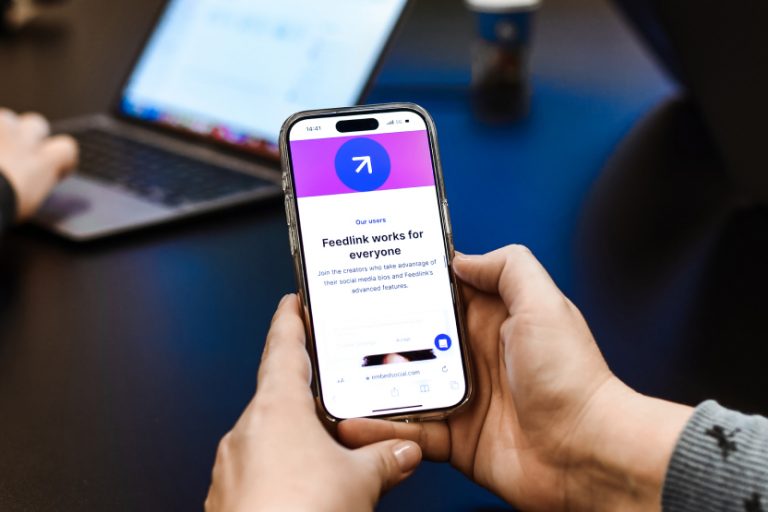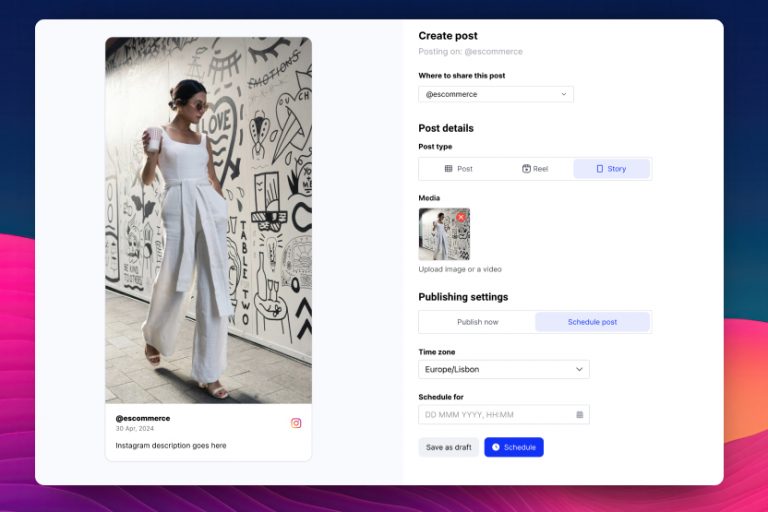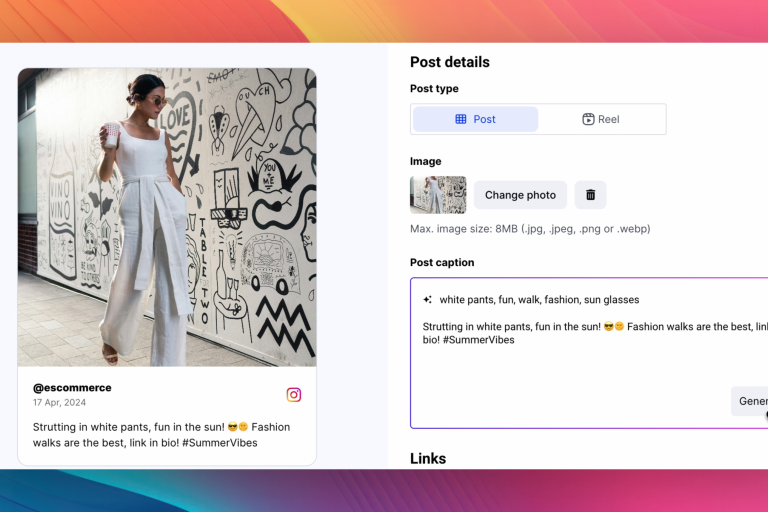Marketers nowadays have many tools to boost their brand’s image and get new business opportunities, but they should not forget the humble newsletter!
E-mail marketing has always been relevant, and well-crafted newsletters are still the best marketing tool to cut through the digital noise.
So to foster genuine connections with your audience, you definitely need to read this guide on creating a successful email marketing strategy via newsletters.
Buckle up and let’s unleash the power of the inbox!
Need an email newsletter tool?
Start a social media newsletter in seconds
What is a newsletter?
While they are sent by email, newsletters are not traditional email messages but rather curated invitations packed with valuable content tailored to a brand’s followers—even if they are sent in bulk to a group of email subscribers, they are still relevant to the recipient’s interests.
Think engaging updates, expert tips, exclusive behind-the-scenes glimpses, and maybe even a sprinkling of irresistible offers and discounts. All of them rely on the direct line of communication provided by the newsletter email to foster a closer relationship with your customer base. There’s rarely a better way to stay relevant and build a community around your brand.
You’ll find newsletters come in various formats, from text-based to visually rich with images and videos. Their mailing frequency should also vary depending on your marketing strategy and the expectations of your audience, from daily to monthly or even quarterly.
For instance, check out Calvin Klein’s Christmas newsletter, which is attempting to capture everyone’s curiosity with its gorgeous design and discount promise:
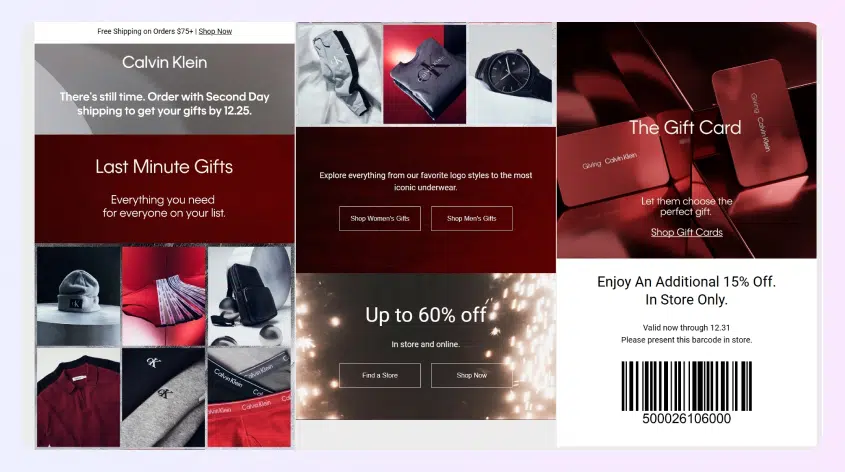
View these Top 15 Newsletter Examples for Small Business Owners [2024 Edition] to get a sense of high-quality newsletter samples.
Why include a newsletter in your email marketing strategy?
Newsletters are more than email blasts and sales pitches; their goal is to build trust, share valuable insights, and create loyal fans who champion your brand.
Here’s a glimpse of all the purposes that newsletters serve:
- They give you direct access to your audience—newsletters are delivered straight to your subscribers’ inboxes, a direct line of communication you control. Just like leaving a captivating magazine on your subscribers’ coffee table regularly;
- They help you target certain groups—unlike regular emails, newsletters can be segmented and personalized for different groups of subscribers, which increases their relevance and engagement, making your content feel like a conversation;
- They help you build relationships and loyalty—newsletters offer a platform to showcase your brand personality, share insightful content, and offer exclusive perks, which fosters trust and community, turning subscribers into your brand champions;
- They offer a cost-effective reach—compared to other marketing channels, newsletters are remarkably affordable. After all, the cost per email sent is low, and the return on investment can be high, especially with effective content and targeting;
- They produce measurable results—you can track open rates, click-throughs, and other metrics to understand what resonates with your audience and guide your content strategy. This data-driven approach helps you fine-tune your newsletter for maximum impact;
- They come with a long-term value—unlike fleeting social media interactions, newsletters nurture relationships over time. When done right, subscribers stay engaged, learn about your brand, and become more likely to convert into customers as their familiarity grows;
- They are flexible and versatile—from informative articles to exclusive discounts and social media updates newsletters can accommodate diverse content formats and goals. This keeps your audience interested and allows you to experiment with different tactics;
- They boost your organic reach—a loyal newsletter audience translates to increased social media sharing, website traffic, and word-of-mouth recommendations. This organic amplification extends your reach beyond your subscriber list and fuels further growth.
As you can see, newsletters are very powerful for building loyal communities, fostering brand engagement, and ultimately driving business growth.
Therefore, you should know better than to disregard this cost-effective and measurable marketing tool. So, keep on reading as we reveal the secrets of crafting the perfect newsletter for your small business.
Creating a newsletter strategy in 9 simple steps:
- Choose the right email newsletter platform
- Figure out your newsletter goals
- Get more newsletter subscribers
- Set up segmented newsletter lists
- Pick and customize your newsletter template
- Fill your newsletter with valuable content
- Ensure your newsletter is legally compliant
- Start sending your regular newsletter
- Track your newsletter performance
1. Choose the right email newsletter platform
The very first step on your newsletter journey is finding the best email newsletter platform to help you establish a strong foundation for your email campaign. However, with so many options out there, how can you know which platform to pick to empower your small business?
There are three main steps to this process:
Know your needs:
- Audience size & growth—consider how many subscribers you have and your projected growth rate since while some platforms cater to smaller lists, others scale effortlessly with thousands of subscribers. So choose one that can accommodate your exact needs;
- Budget & pricing—platforms offer a range of pricing models, from free tiers with limited features to robust plans with advanced tools. So assess your budget and prioritize features that matter most to your goals, like automation, analytics, or integrations;
- Functionality & features—not every option is created equal! While some focus on ease of use and drag-and-drop design, others offer advanced automation tools and in-depth analytics. Adjust the features offered to your marketing strategy and technical skills.
This is what Brevo’s drag-and-drop editor offers its users:
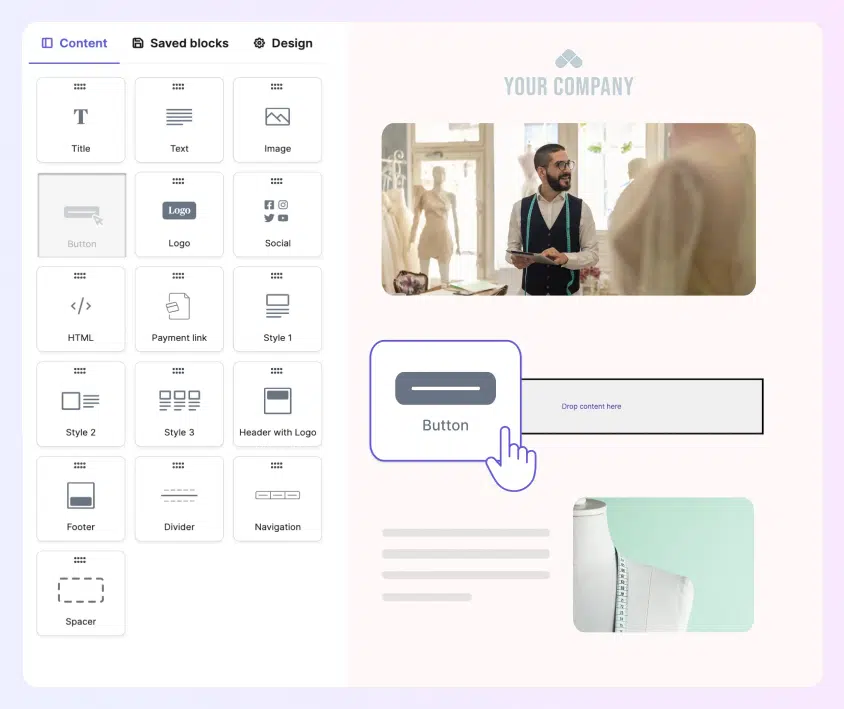
Explore the options:
- Popular choices—platforms like Mailchimp, HubSpot, Constant Contact, and Brevo are well-established players with diverse features and user-friendly interfaces. First, exploring these alternatives to get a good sense of the available options;
- Specialized options—consider niche platforms that cater to specific needs. If you’re a small business brand, Feedlink is the perfect option. Conversely, if you represent an e-commerce platform, you should look into Klaviyo and Omnisend. Lastly, for visual storytelling, platforms like Canva or MailerLite offer unique advantages;
- Read reviews & compare—we don’t have to tell you that you should always read reviews about the products you are looking to purchase and compare them to other alternatives. Real users experience the pros and cons of every option out there.
For instance, G2’s lists over 550 email marketing software options:
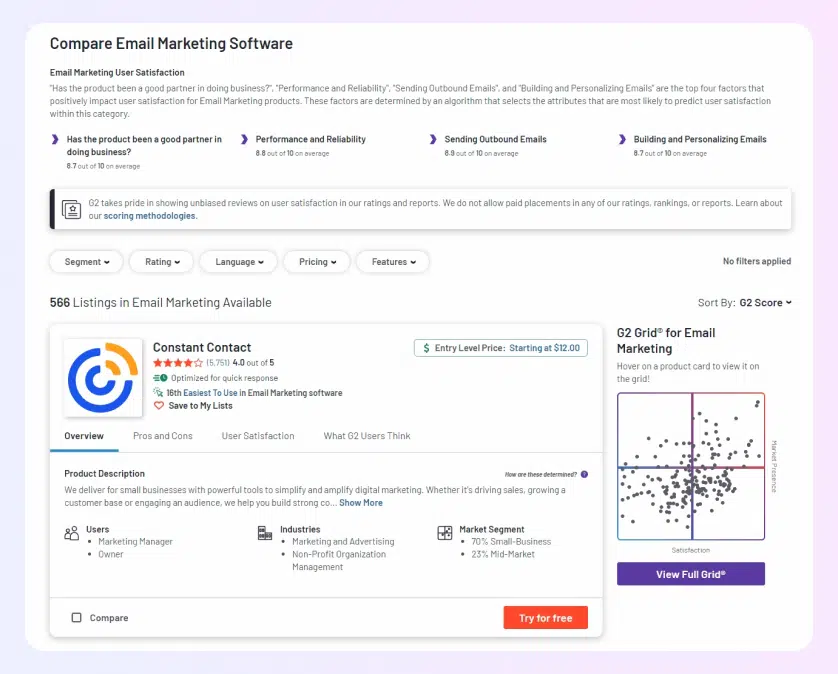
Test & choose wisely:
- Free trials & demos—most platforms offer free trials or demos, so take advantage of them! You can test out the interface, explore the various features they offer, and get a strong feel for the platform’s usability before committing;
- Prioritize user experience—you should definitely choose a platform that’s intuitive and easy to use if you are a beginner (or even if you aren’t). Focus on platforms that help you create gorgeous newsletters without knowing how to code;
- Seek support—always consider the platform’s support options. Do they offer helpful onboarding resources, responsive customer service, and active communities for troubleshooting? Strong support is invaluable, especially for beginners.
As an example, Feedlink comes with a Blog, Help Center, and Live Chat options:
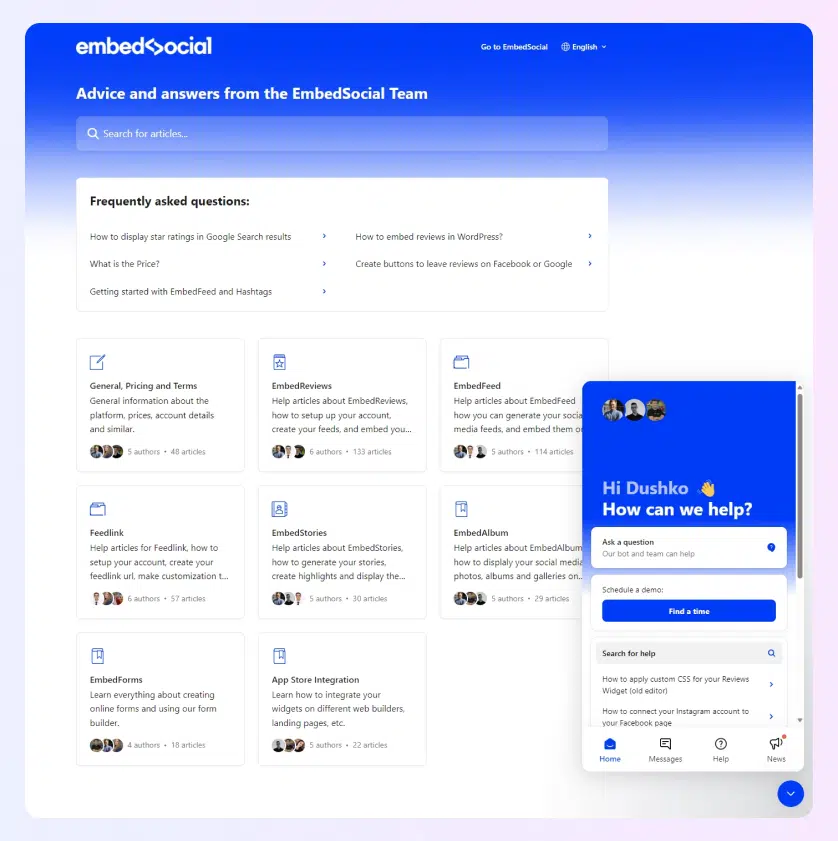
Remember, the right platform should enhance your creativity, support your growth, and make email marketing a joy, not a chore. There’s no way around it: you must do your due diligence in exploring all the options on the market before you commit your resources.
Social media newsletter campaign
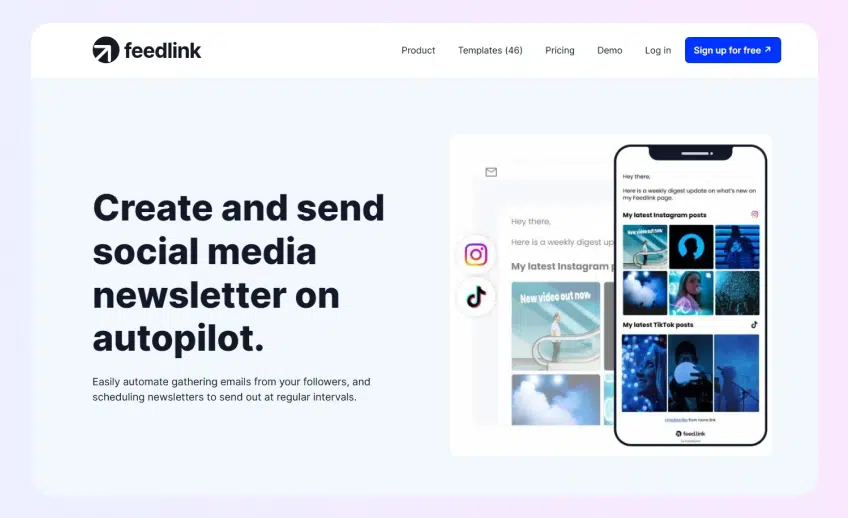
One excellent and compact alternative you should look into is Feedlink since it incorporates a fantastic newsletter feature—compact, automatic, and effective!
That said, Feedlink focuses primarily on creating newsletters from your social media posts and lacks some advanced customization options like the specialized alternatives.
However, with this platform, you are getting much more than the ability to automatically create newsletters every week from your best social media updates. In fact, with a minimal fee, you get the full toolset you need to help your business skyrocket in no time at all!
Where to start? In addition to newsletters, Feedlink helps you create and post blogs, present all your links on a single page, embed your social media posts, add a subscription block, various text and visual blocks, RSS feeds, digital cards, Google locations, and more!
You can always try the social media newsletter for 7-day free trial.
Need an email newsletter tool?
Start a social media newsletter in seconds
2. Figure out your newsletter strategy
While looking at email marketing software that will help you design your newsletter, you should also be considering your newsletter goals. At the end of the day, you must ensure your every email blast gets to the right audience, captures their attention, and drives more business.
Every successful newsletter out there is goal-oriented and very deliberate in its audience targeting. You can also create such a newsletter by asking yourself these questions:
- Who are my customers and what do they want? Once you know who you’re trying to reach, you’ll know what kind of content to offer in your newsletters. To figure that out, you need to construct your ideal customer personas and offer them what they need!
- What’s my newsletter’s overall goal? Are you aiming to connect with your audience and build a long-term relationship? Or are you trying to educate them, sell to them, or ask for customer feedback? You can also give out discounts for referrals!
- What content should I offer my customers? You can determine whether to include exclusive offers, information about your product and company, or rich blog articles by asking your signups what they want to read when they sign up for your newsletter.
- How often will I send my newsletter? You should never overburden your potential customers to the point they want to unsubscribe from your newsletter. For that reason, ask them how often they want to receive it and then segment your mailing list further.
- When should I ask them to sign up? A well-placed subscription CTA can be the difference maker in whether or not you grow your audience. You can place it on your home page, in your blog posts, or best of all: include a link in your product checkout pages.
- What value will my newsletter provide? Lastly, you should also think about providing real value to your subscribers. They must feel like they are getting something out of your newsletter, be it a discount coupon, product information, or industry insight.
Once you have the answers to these questions, you’ll be prepared to create a targeted newsletter that will achieve what it sets out to do: satisfy your business ambitions.
3. Get more newsletter subscribers
Time to build your army of loyal followers by growing your mailing list. You can use various tools for this purpose, including social media, incentives, and webpage optimization:
Remember, you have to embed a subscribe email block on your website or link in bio page in order to have a one page where you will be able to show incentives or use the subscribe block as a lead agent.
Unleash the power of incentives:
- Wow them with freebies—offer exclusive discounts, downloadable guides, or early access to new products. For example, you can give them a sneak peek at your new clothing line or a free recipe book, all of which will also include your email subscription CTA.
- Contests & giveaways—everyone likes to participate in free contests with the promise of winning an enticing prize. You can host various giveaways related to your niche, offering subscriptions or products. But to enter, candidates have to join your newsletter.
Leverage the power of social media:
- Promote your newsletter like a pro – you must promote your newsletter across your online portals, including your main website and social media channels, like adding the URL to your newsletter subscription page in the ‘Visit my website’ option on LinkedIn. Additionally, you can show off its quality by sharing snippets of your best content and teasing upcoming exclusives.
- Cross-promote across platforms—think about running joint promotions with other relevant businesses or influencers. Offer exclusive newsletter discounts or early access to shared content, and tap into their audience to expand your reach.
Additionally, you should optimize your website to welcome new subscribers by implementing strategic pop-up forms across your pages and creating dedicated landing pages with clear CTAs and irresistible signup offers. However, whatever you do: make it easy to subscribe!
For instance, adding a subscription block in Feedlink takes a few clicks as you see from the screenshot below. After that, your following will keep growing!

Bonus tip: You can A/B test different signup forms, headlines, and offers to see what resonates best with your audience. Data is your friend, so always rely on it!
4. Set up segmented newsletter lists
Treating each one of your subscribers like a VIP is very important, and the way to do that is to send them out a personalized version of your newsletter based on their preferences.
Subscriber segmentation is the key to that goal. You must divide your audience into smaller, targeted groups to boost engagement and drive more results with your content.
Harness the power of data:
- Demographics & interests—leverage data like the subscribers’ age, location, and purchase history. That way, if you are a fashion brand, you can offer tips and hip clothes to your younger audience and classic outfits to your older demographic;
- Behavior & engagement—track how subscribers interact with your emails. Those who open regularly and click on links are prime candidates for exclusive content, while less active subscribers might need a re-engagement campaign.
Craft content that connects:
- Create tailored topics—once you’ve segmented your audience, meet their specific interests and needs with catered content. For instance, a cooking enthusiast wouldn’t be thrilled with tech updates, and vice versa;
- Offer relevant incentives—tailor your discounts, promotions, and freebies to each segment. Imagine offering a discount on a new gardening tool to your green-thumbed subscribers or a free e-book on finances to your budget-conscious audience.
Use email marketing tools:
- Rely on email marketing platforms—most platforms offer built-in segmentation features, making creating and managing different lists easy. Utilize their power to automate your segmentation process and save valuable time;
- Inform decisions with analytics—track the performance of your segmented campaigns. See which segments respond best to certain content or offers, and use that data to refine your newsletter content strategy continuously.
Bear in mind that you should start small (two to three groups) and then expand your segmentation efforts as you grow your audience. Also, you must remain flexible at all times! The final goal is to offer a personalized experience to each one of your subscribers! That way, your engagement will soar, conversions will climb, and your small business will thrive.
5. Pick and customize your newsletter template
Your newsletter is more than just words on a screen—it’s a visual experience that should reflect your brand, engage your audience, and guide them toward your CTAs.
Thankfully, most newsletter platforms come with an easy-to-use editor and plenty of design templates to create the perfect newsletter. Just follow a few steps:
- Get inspiration from other top newsletter examples;a) Check the Top 15 Newsletter Examples for Small Business Owners.
- Review the design features of the various platforms;a) Mailchimp, HubSpot, and Venngage come with pre-made templates.
- Inspect your visual identity to remain consistent across your brand;
- Focus on having a clean, responsive layout that works on mobile, too;
- Tweak your chosen template to have it consistent with your website;a) Experiment with the colors, fonts, and image placements.
- Structure your layout to guide your readers’ eyes;a) Use headlines, subheadings, bullet points, and images.
- Add a clear CTA near the bottom of the newsletter;a) Use clear buttons, persuasive language, and enticing offers.
As an illustration, check out a sample of Canva’s large newsletter template library that can be further customized to fit your website’s design language.
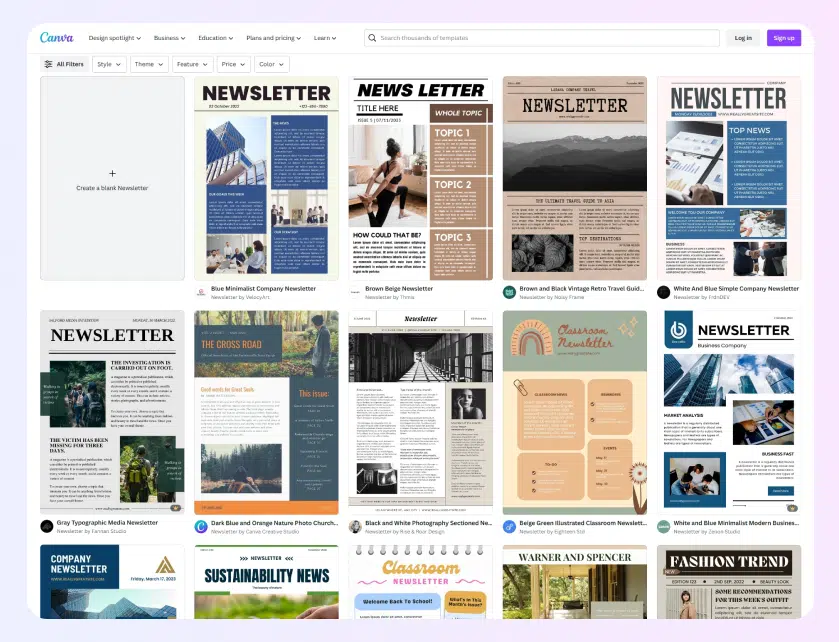
While you can spend a lot of time creating the perfect newsletter template, you also don’t have to if you have pressing matters at hand. In that case, you can either use a template as it is or rely on a platform like Feedlink to autogenerate and auto-populate your newsletter.
Unlike the other full-suite alternatives for creating newsletters, Feedlink streamlines the entire process. You only choose the social media channels you want in your newsletter for Feedlink to create the newsletter and start sending it regularly with fresh content.
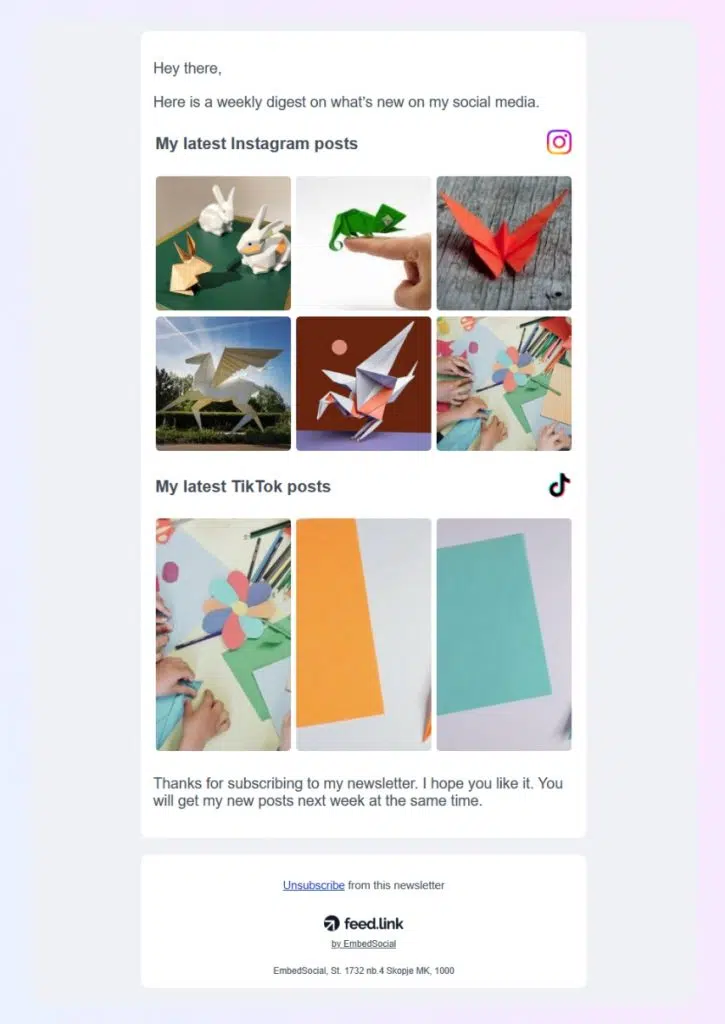
6. Fill your newsletter with valuable content
Let’s fill your newsletter with content that captivates, informs, and drives your audience toward your goals. Remember, your newsletter is a conversation, not a monologue.
First of all, you shouldn’t always send dry text-based newsletters. Experiment with different content formats like blog snippets, short videos, infographics, or even customer testimonials. You must offer something for everyone, which will also allow you to see what works!
Your newsletter is also your opportunity to provide valuable insights and updates relevant to your niche, in addition to the fun factor. So you can intersperse informative articles with anecdotes, relatable stories, or behind-the-scenes glimpses. But, don’t forget to showcase your knowledge and passion for your business by sharing tips, news, and actionable advice.
Why not enhance all that by using high-quality, evocative visuals? Or even adding a recorded intro and outro? Use as many mediums of communication as you can!
For example, this visually rich newsletter example of a vegan food delivery service offers a bit of everything: an informative guide, gorgeous images, and useful advice!
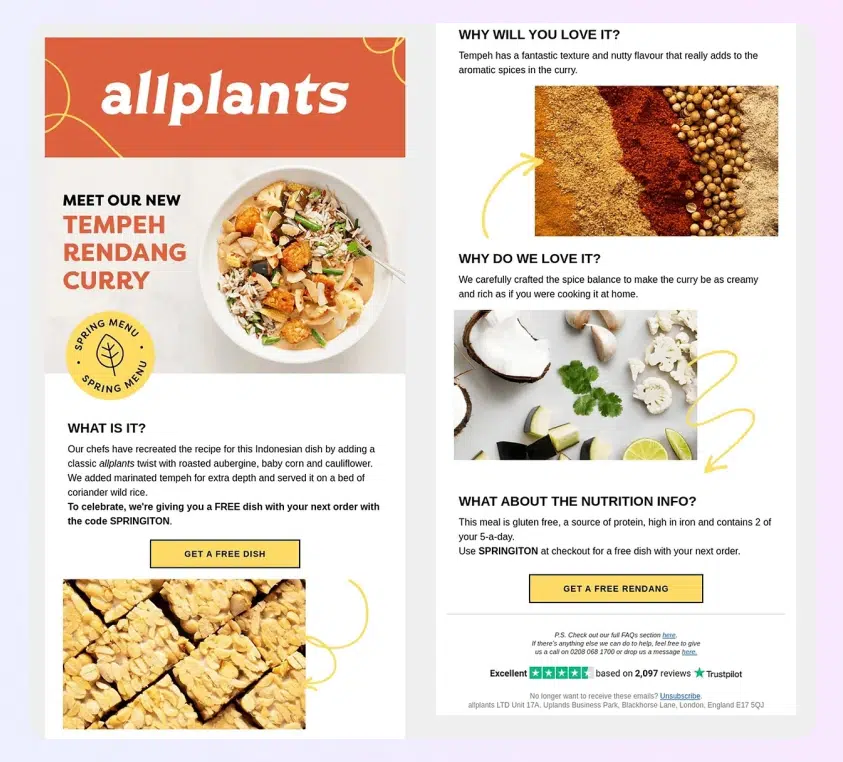
At the end of the day, quality reigns supreme, so you want to add a piece of content with a purpose: to drive traffic to your website, promote your sales, and convert your visitors. Needless to say, you must proofread everything before sending it out to keep their trust.
7. Ensure your newsletter is legally compliant
Running a small business means playing by the rules, and there are a few legal requirements you must meet when publishing a newsletter in favor of your subscribers:
- CAN-SPAM—a legal act that requires you to have a footer in your newsletter offering your customers an easy way to unsubscribe from your emails;
- GDPR—Europe’s new privacy laws only allow you to send newsletters to users who have chosen to receive them and you must protect their data in any circumstance;
- Accessible design—ADA standards require you to offer accessibility for users with disabilities; for that reason, you should use high-contrast colors, alt text in images (not all email providers load images correctly), and simple and clear language and navigation.
Ultimately, you don’t need laws telling you what to do, and you must always take sensible precautions to protect your customers and their privacy. You should also strive to avoid email clients with spam filters by sending clean and relevant newsletters. That’s the way to build a solid reputation.
8. Start sending your regular newsletter
Ready to start sending out your inviting newsletters? There are a few things to keep track of to maximize its efficiency, including but not limited to the following:
- Schedule like a pro—you must determine your regular sending frequency. Will it be a weekly dose of joy, a monthly masterpiece, or something in between? Or why not ask your customers how often they want to receive your newsletter? One more thing to keep in mind: weekday mornings and weekend afternoons are the optimal times to send out your blast;
- Write a catchy subject line—your email subject line should always pique curiosity and entice readers to open it. You can A/B test different options to see what resonates best with your audience. Remember, attention-grabbing doesn’t have to be clickbait!
- Test, test, and test again—before pressing the send button, conduct a test send to yourself or a trusted few. Check for typos, broken links, and any formatting issues. You can also utilize email preview templates to see how your newsletter will look in different inboxes. Ensure images and formatting are displayed flawlessly across platforms.
- Stay the course—if your open rates are not what you wanted at the start, don’t get discouraged since building an engaged audience takes time and effort. You just keep delivering valuable content, tracking your results, and tweaking your approach;
- Analyze & adapt—rely on email analytics to understand what’s working and what isn’t. There’s a lot to be learned from both your successes and your failures. Also, ask your subscribers to give you feedback that you can use to improve your content.
One last thing: you must publish regularly since consistency is key! For example, Feedlink aggregates your social media content and sends out newsletters each week. Plus, this newsletter autopilot feature is very easy to set up!
However, some other businesses, especially e-commerce shops practice a very aggressive newsletter strategy and send out one (even two) per day:
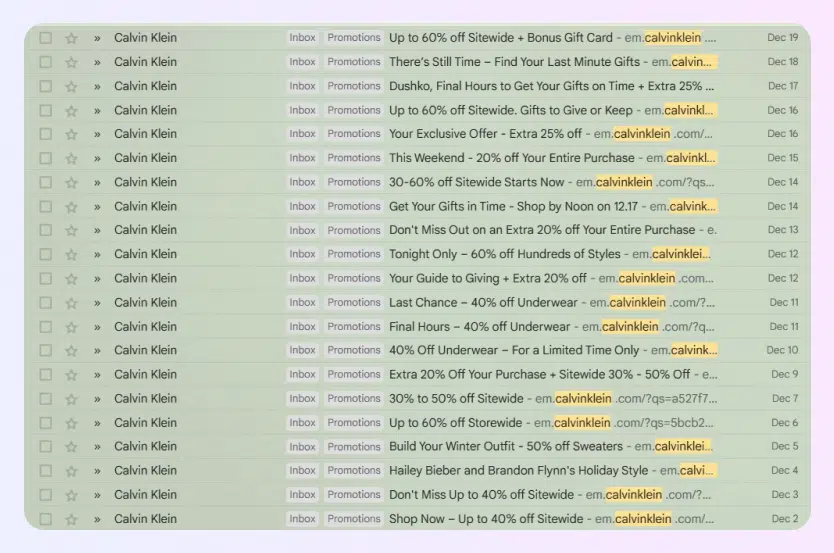
For that reason, you must keep a consistent publishing schedule as your audience needs to know when to expect your next content dose. Needless to say, you must deliver quality every time—treat each newsletter like a masterpiece of visuals and valuable information. Once you achieve that, you can set your email service provider to send your regular blasts on time.
9. Track your newsletter performance
We are not done yet! There’s one last step that you will actually have to do over and over again: continuously track and optimize your newsletter’s performance!
To achieve that goal, you can rely on your chosen email marketing platform, plus several other tools, such as Google Analytics, which tracks how your newsletter drives visitors to your site, how long they stay, and what actions they take. Additionally, you should also send out the occasional survey to gauge your audience’s opinion on your content quality and frequency.
Typically, you’ll be looking into several metrics:
- Open rates—are people even opening your emails? If not, try different subject lines, sending times, or content topics. Remember, an unopened email is an unread story!
- Click-through rates—are your readers engaging with your content and clicking on your links? If not, analyze your calls to action, the relevance of your links, and the overall flow of your emails. Clicks are the stepping stones to conversion!
- Unsubscribe numbers—are people leaving your party early? Look for patterns in unsubscribe timing, content areas, or specific emails to get clues to retention;
- Conversions & revenue—does your newsletter drive sales, leads, or other desired actions? Track these metrics closely and tailor your content and offers to maximize your return on investment. Remember, your newsletter is a business tool!
Once you get and analyze the needed data, you can adapt your newsletter strategy. Also, observe trends over time. Is your open rate declining or increasing? Is the click-through rate spiking for certain content? Identifying trends lets you make proactive adjustments.
Newsletter tips for a successful email marketing strategy
There’s more to creating a successful newsletter strategy than just throwing together some text and pictures and hitting send. You must understand your audience, provide valuable content, and make sure your emails are opened and read. Here are some additional tips and tricks:
Know your audience:
- Who are you trying to reach with your newsletter? What are their interests and needs? Once you know your audience, you can tailor your content to them.

Segment your list:
- Don’t just send the same newsletter to everyone. Segment your list based on demographics, interests, or purchase history to create content relevant to your subscribers.
- Check out Mailchimp’s detailed segmentation filtering options:

Create valuable content:
- Your newsletter should provide value to your subscribers. This could be in the form of informative articles, tips and tricks, exclusive discounts, or behind-the-scenes content.
- As an example, Calvin Klein’s Christmas newsletters offer a sizeable discount:

Keep it short and sweet:
- Everyone is busy nowadays. Because of that, no one wants to read a long and boring newsletter. Keep your emails concise and to the point.
- This is the extent of Glossier’s latest newsletter: a story about a London make-up artist, the tools she’s been using, and CTA buttons to get them yourself:
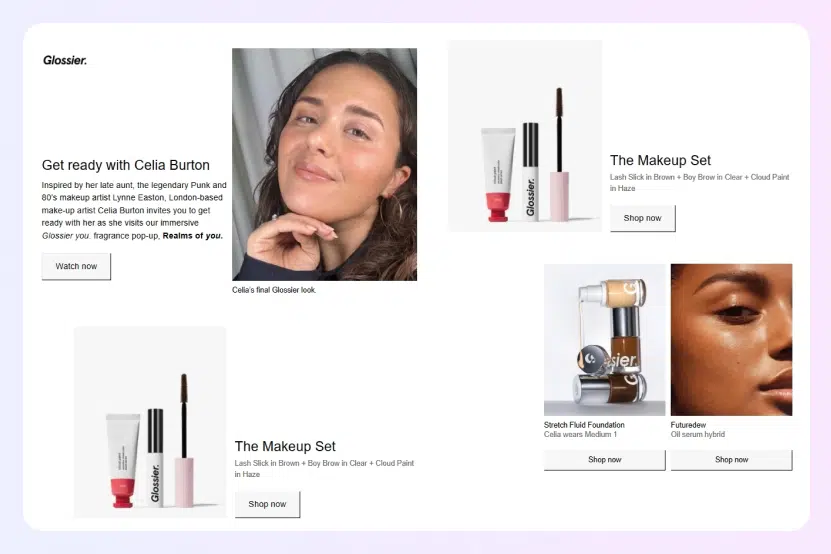
Use catchy subject lines:
- First of all, you must hook your potential readers with a catchy title. Make sure it’s attention-grabbing and relevant to the content of your email.
- “25% off everything”—if that doesn’t grab your attention, we don’t know what will:

Design for mobile devices:
- Mobile usage has been growing exponentially and now most emails are read on mobile. Therefore, your newsletter must look good on small screens, too!
- InVision’s perfect newsletter design looks gorgeous on either platform:

Use strong visuals:
- Images and videos can help break up your text and make your newsletter more visually appealing. Like it or not, visuals are a staple of every written post nowadays.
- La Playa Gallery made a video of a painting session the star of its newsletter:

Make it easy to unsubscribe:
- People should always have the option to unsubscribe from your newsletter. Make it easy for them to do so with a clear and prominent unsubscribe link.
- Almost every newsletter (like Lush here) adds an ‘Unsubscribe’ button in the footer:

Track your results:
- Once you’ve sent your newsletter, track your results. See who has opened it, clicked on links, and unsubscribed. This data can help you improve your future newsletters.
- Google Analytics helps you track all sorts of metrics for your newsletters:
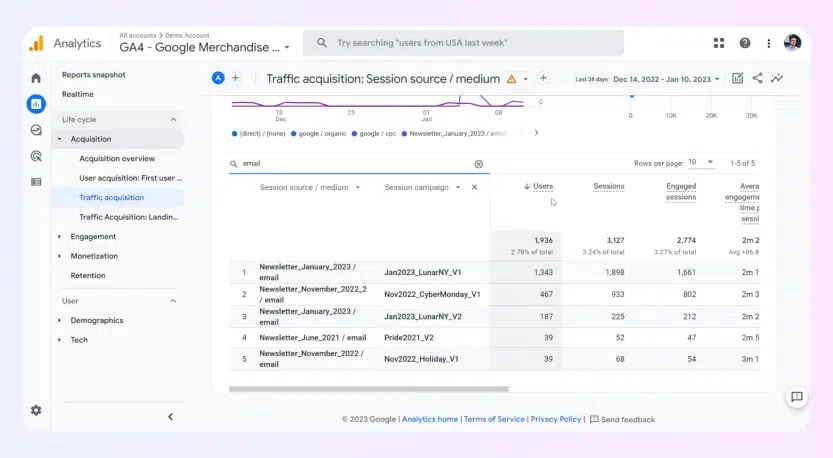
Additionally, you should use a consistent sending schedule, personalize your emails, try out a different subject line and email formats, and use a call to action. Trust us, all these tips will help you connect with and grow your audience at an unprecedented rate.
Conclusion: Rely on a good email marketing software
After creating your business blog, your newsletter should be next on your to-do list since it’s still one of the best ways to reach a new customer base.
Plus, making a newsletter in today’s day and age has become a breeze as long as you have a can-do attitude and the right email marketing tool.
You only have to set up your mailing list and create your newsletter design, which is easier than you think since most of the above software solutions come equipped with ready-to-use newsletter templates.
Then, the only thing left to do is assess the effectiveness of your newsletter strategy, reap the rewards, and continue improving your newsletter strategy.
FAQ
What is the easiest way to create a newsletter?
Arguably the fastest method to create a high-quality newsletter is by subscribing to an email marketing platform, selecting a customizable template, and adding your content.
Can I create a newsletter for free?
Yes, certain platforms like Mailchimp and Brevo offer a free account with basic features, which will allow you to create and send out a newsletter to your customers.
How do I start writing a newsletter?
The first steps include identifying your audience and their interests, deciding on the main topics or themes of your newsletter, and creating a content outline.
What is the best structure for a newsletter?
The best structure for a newsletter includes a compelling subject line, a brief introduction, segmented content with headers, visual elements, and a clear call to action.
Need an email newsletter tool?

